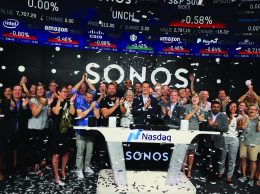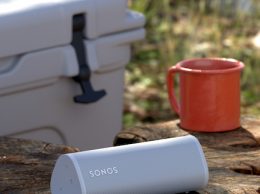Though Sonos is remaining characteristically tight-lipped about its financial plans, it seems safe to say an initial public offering is not on the company’s wish list this year.
The Santa Barbara-based maker of high-end wireless speakers, founded in 2002, is finally hitting its stride as streaming services represent an ever-growing share of music delivery, making the firm ripe for acquisition or an IPO filing. But instead, privately held Sonos is determined to hold its focus on marketing and product development — for now.
The company preserved its autonomy while maintaining its status as an attractive acquisition with the sale of $130 million in secondary equity, giving eight early shareholders a chance to cash out. Existing backers, who have already invested more than $200 million before the latest round, include KKR, Index Ventures, Redpoint Ventures and Elevation Partners.
Sonos PR Manager Eric Nielsen said in an email to the Business Times that the company would not comment on the deal aside from affirming that the funding is “just a secondary round strictly raised as a part of our ongoing liquidity program for employees, not a new round of capital.”
The consumer audio gear maker is a South Coast behemoth, with $535 million in 2013 revenue — nearly doubling that of 2012 — and 400 employees sprawled across 100,000-square-feet at its downtown Santa Barbara headquarters. Its property holdings make it the largest private-sector tenant in one of the nation’s most coveted commercial markets.
At a recent conference, CEO John MacFarlane said he expects revenue to exceed $1 billion this year. With healthy finances, Sonos’ next project will be to establish itself as a household name.
A national television ad campaign launched Oct. 12 combines buoyant pop-art animation with mesmerizing tunes, encouraging viewers to “Sonos your home.” Some of the first ads aired in conjunction with the NFL football broadcast on CBS.
But such noise has only made the competition louder. Earlier this week, electronics maker Phillips introduced a line of competitively priced streaming speakers, vying for Sonos’ spot at the forefront of multi-rooms offerings. It will also be up against efforts at tech behemoths that are taking stream integration even further. Amazon, for example, recently introduced the Fire TV media player, which helps the company bait return customers by offering virtually free music, video and e-book downloads.
To equip itself for such a battle, Sonos made a strategic, high-profile hire in March when it recruited Marc Whitten, then the chief product officer of Xbox, to become its new chief product officer.
Sonos’ product model can also claim a small victory over arch-rival Apple, which awaits in the next few weeks the decision of a lawsuit from the early days of digital music, when Steve Jobs pushed the company to solidify its place in the market by blocking competitors’ file formats from playing on its then-ubiquitous iPod. Sonos’ leverage rests with its ability to adapt to the demands of the connected home promised by the advent of the Internet of Things.
In October, Sonos released a major software update enabling its speakers to connect to WiFi directly; before, users who wanted to tap its streaming services had to set up a wired connection between a router and one of the system’s speakers or a secondary component, the $50 Sonos Bridge.
But now most people carry a music player in their pockets. Sonos could win big if it develops a way for its streams to follow users as they move around the house — if not, its technology may be abandoned in favor of more mobile services.
The company did make some moves this fall to vie for pole position in the Internet of Things race. In October it released a product called Boost, a $100 WiFi amplifier that promises to bring commercial-grade stability and range to household wireless networks.
To distinguish its offerings going forward, the company may have to build on the Boost’s appeal as a multi-purpose signal strengthener across technologies.






 Print
Print Email
Email

















